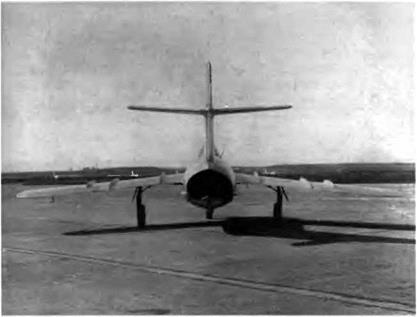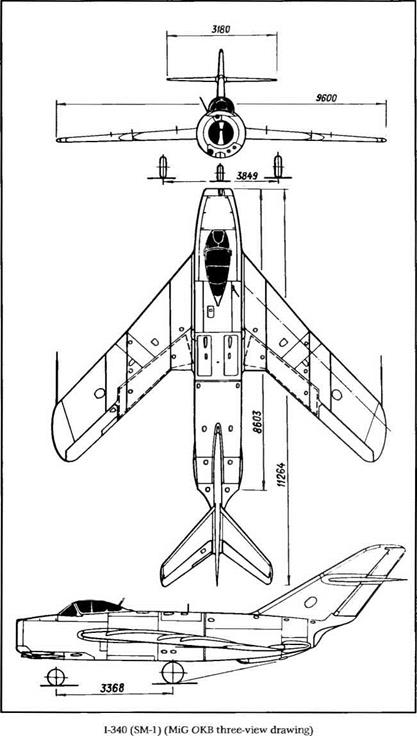L№G-17 /1340 / SMI
When they began work on the preliminary design of a fighter capable of breaking the sound barrier in level flight in 1950, the OKB engineers decided to power it with a new, smaller Mikulin turbojet. At that time Mikulin, the engine manufacturer and academician, had just developed a big and powerful turbojet, the AM-3, to power the Tu-16 bomber. Rated at 8,575 daN (8,750 kg st), it was probably the most powerful jet engine in the world Of course, it was much too large to use in a fighter. So Mikulin hit upon the idea of developing an engine with the same layout, operating cycle, and architecture as the AM-3 but on a scale one-third as large
On 30 June 1950 Khrumchev, minister of the aviation industry, Mikoyan, Yakovlev, and Mikulin were called to the Kremlin to discuss the plans for the engine that, by decree of the USSR council of ministers, would power the new Yakovlev and Mikoyan fighters This engine, referred to as the AM (Aleksandr Mikulin)-5, was not an immediate success Numerous adjustments proved to be necessary, and it was obvious that they could be performed best on a flying test bed rather than a factory test bench. Mikoyan, who was very interested in the new engine, offered to install two AM-5s side-by-side in a MiG-15, a proven aircraft For his part Yakovlev proposed arranging them in pods under the wing of his new fighter, the Yak-25
In the end the first two AM-5s replaced the single VK-1 of the MiG – 15 bis 45 (the experimental aircraft that had led the wray to the MiG – 17) This modification was approved on 20 April 1951 by the council of ministers and renamed the SM-1. The prototype rolled out of the factory at the end of 1951 and was put into the hands of test pilot G A Sedov The goals of the SM-1 tests were to improve on the performance of the MiG-17 with a minimum of modifications and to bring the AM – 5A to the required level of reliability and fuel efficiency
The AM-5A had no afterburner, and its maximum rating was 1,960 daN (2,000 kg st) But the thrust of the two engines together was greater than that of a single VK-1 F with reheat. Moreover, the two AM – 5As weighed 88 kg (194 pounds) less than one VK-1F Yet it quickly became apparent that the thrust of the AM-5A was inadequate to meet the design specifications Mikulin then decided to add an afterburner to the engine, which thus became the AM-5F and was rated at a maximum dry thrust of 2,015 daN (2,150 kg st) and a reheated thrust of 2,645 daN (2,700 kg st). Both fuel tanks—with capacities of 1,220 1 (322 US gallons) and 330 1 (87 US gallons)—were located m the fuselage behind the cockpit. To accommodate the required increase in airflow, the engine air intake ducts were widened. A canister for a 15-m2
|
The typical shape of the SM-l’s dual exhaust nozzles The aircraft was used as a test bed for the AM-5 engine. |
(161-square foot) tail chute was attached to the fuselage under the tail section.
The AM-5F development flights with the SM-1 and later the SM-2 convinced Mikoyan, Mikulin, and other experts that the thrust of this engine was still inadequate for the next generation of Soviet aircraft. Mikulin embarked immediately on the creation of a new afterburner and increased the engine compressor output from 37 to 43.3 kg/sec. Out of this came a much more powerful turbojet, the AM-9, later renamed the RD-9B. The top speed of the compressor’s first stage was already supersonic, and with the afterburner the thrust reached 3,185 daN (3,250 kg st). This was the engine that the MiG OKB counted on for its new supersonic interceptor.
Specifications
Span, 9.628 m (31 ft 7 in); overall length, 11.264 m (36 ft 11.5 in); fuselage length, 8.603 m (28 ft 2.7 in); wheel track, 3.849 m (12 ft 7.5 in); wheel base, 3.368 m (11 ft 0.6 in); wing area, 22.6 m2 (243.3 sq ft); empty weight, 3,705 kg (8,166 lb); takeoff weight, 5,210 kg (11,483 lb); wing loading, 230.5 kg/m2 (47.2 lb/sq ft).
|
|
Performance
Max speed, 1Д93 km/h at 1,000 m (644 kt at 3,280 ft); 1,154 km/h at
5. m (623 kt at 16,400 ft); climb to 1,000 m (3,280 ft) in 0.16 min; to
5.0 m (16,400 ft) in 0.94 min; to 10,000 m (32,800 ft) in 2.85 min; to
15.0 m (49,200 ft) in 6.1 min; service ceiling, 15,600 m (51,170 ft); range, 920 km at 5,000 m (570 mi at 16,400 ft); 1,475 km at 10,000 m (915 mi at 32,800 ft); 1,965 km at 15,000 m (1,220 mi at 49,200 ft); takeoff roll, 335 m (1,100 ft); landing roll, 568 m (1,863 ft).












